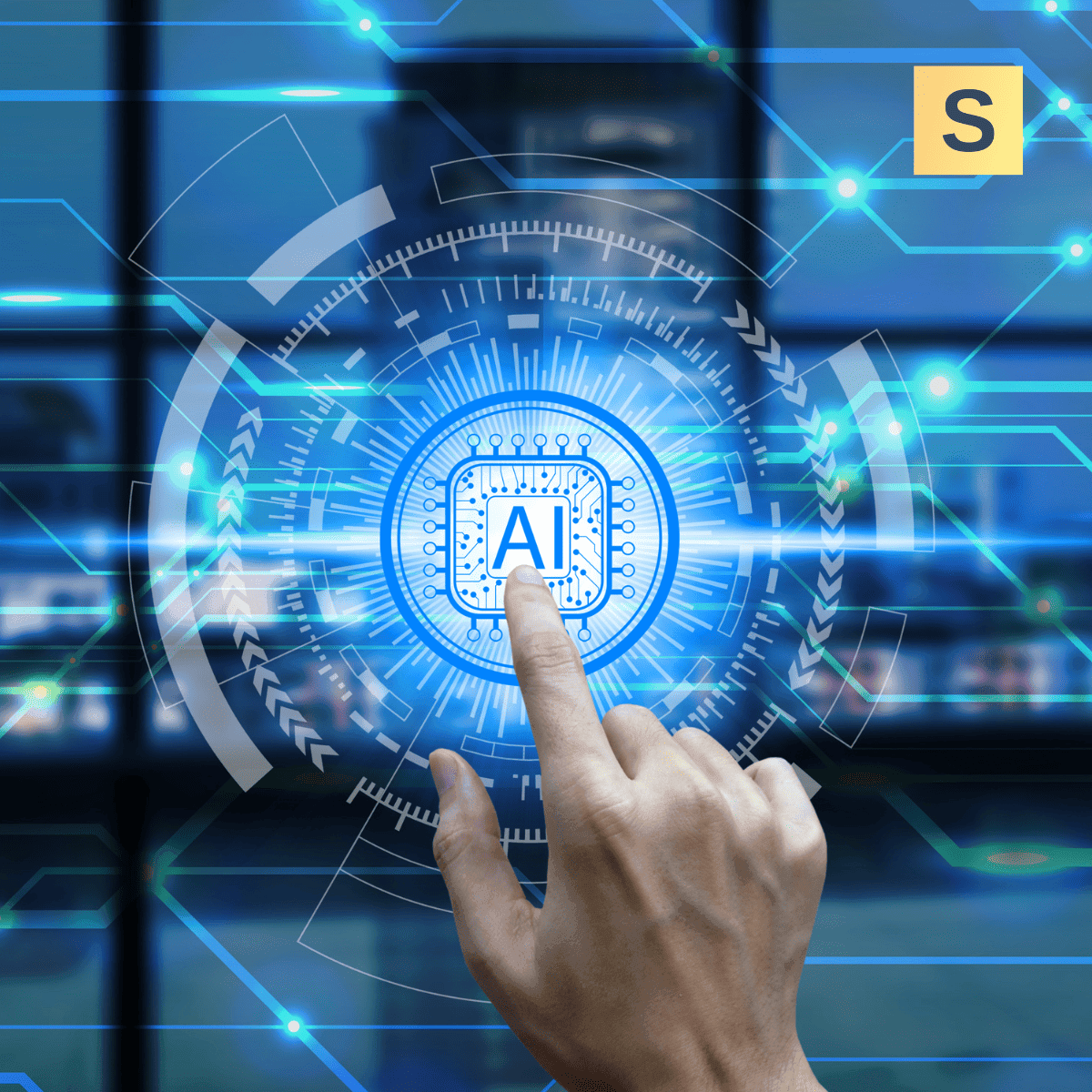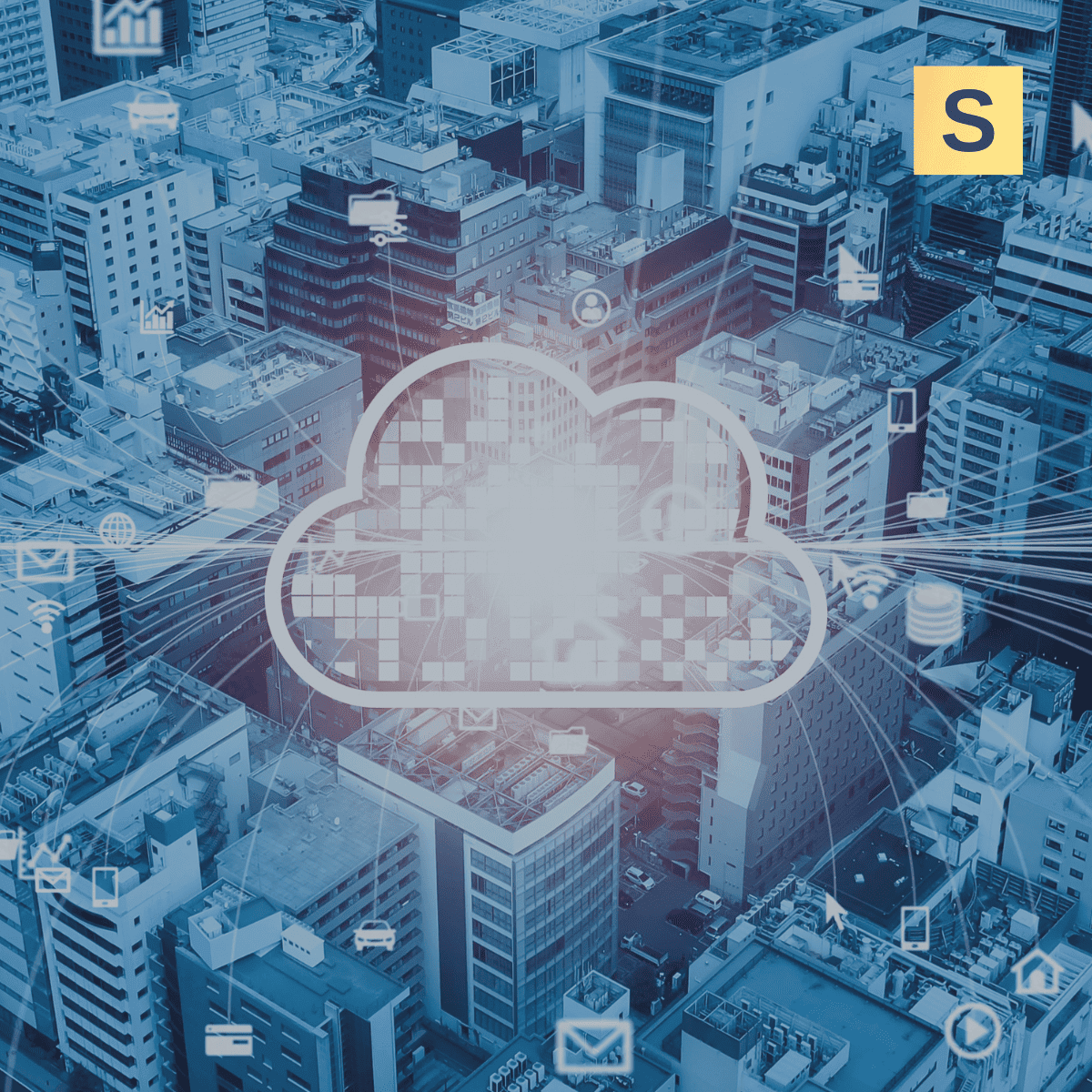With the rapidly evolving nature of the SaaS ecosystem, startups and SMBs developing SaaS products face many challenges. These include finding product-market fit, limited resources, long development cycles, difficulties with scaling infrastructure, and more.
Market trends can shed light on some of the challenges and provide you with proven ideas on how to overcome them successfully. In this article, we collected the latest SaaS trends verified by our over 8 years of experience in SaaS development. No matter what stage of product development you are at, this will help you better understand what is happening in the market and what technologies and approaches can be beneficial for your strategies.
General SaaS Industry Trends: Market Overview
The global SaaS industry is on a high-growth path. The size of the market was approximately $399.10 billion during 2024 and is anticipated to reach $819.23 billion by 2030, with a CAGR of 12.0% from 2025 to 2030.
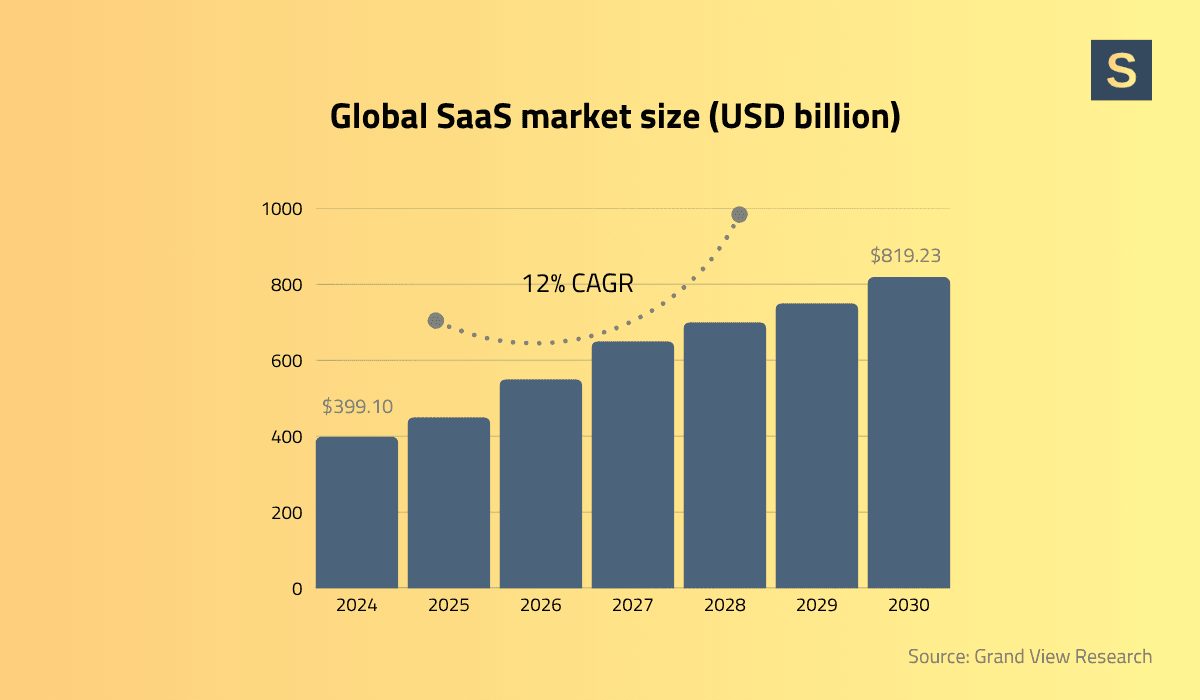
The key drivers of SaaS market growth include the following:
- Cloud end-to-end adoption: With an increasing number of organizations abandoning the legacy infrastructure and adopting cloud-native platforms, SaaS is the preferred delivery model.
- Cost savings: SaaS eliminates initial infrastructure costs and decreases IT overheads. This makes them especially attractive to SMBs and mid-market businesses.
- Remote collaboration: The transition to all-remote and hybrid workforces has fueled growing demand for cloud-based collaboration, communication, and productivity applications.
- Subscription billing models: Robust consumption-based billing models provide better clarity on costs and ROI.
- Maturity in AI and analytics: The capabilities of SaaS platforms allow for easier integration of AI functionality. This may include predictive analysis, automation, and intelligent decision-making.
B2B SaaS Trends: How to Build a SaaS Product Strategy
In today's evolving B2B SaaS industry, product leaders and founders should take more proactive approaches to fuel growth and build actual value. These four SaaS trends we’ll discuss below address critical scalability, affordability, and time-to-value pain points, especially in verticals where user expectations and regulatory demands are shifting fast.
Vertical SaaS: Industry-Specific Solutions Drive Stickiness
Vertical SaaS solutions are built natively for specific industries like healthcare, legal, real estate, and more. Sector-specific workflows, compliance, and data models deliver more functionality and faster out-of-the-box implementation. The vertical SaaS market is expected to reach $157.4 billion by 2025, growing at a CAGR of 23.9% — nearly double the pace of horizontal SaaS.
Why it matters:
Vertical SaaS reduces onboarding time and allows businesses to operate more effectively without the expense of customization. Specialization increases switching costs, thus enhancing retention and lifetime value. It’s also easier to market a product that is focused on specific industry needs.
Seedium projects:
At Seedium, we develop both vertical and horizontal SaaS. In our observations, there is no direct correlation between the type of product and its success. Our portfolio includes more than one general-purpose software solution that has successfully launched and continues to grow.
However, we have noticed that many companies choose a go-to-market strategy through a specific industry, with plans to expand into others later. For example, our client Smarter Contact started as an SMS marketing platform for real estate, but later expanded its functionality to serve over 7 industries.
Learn more about the case: Smarter Contact - SaaS communications platform
Hybrid Pricing Models: Flexibility Monetization
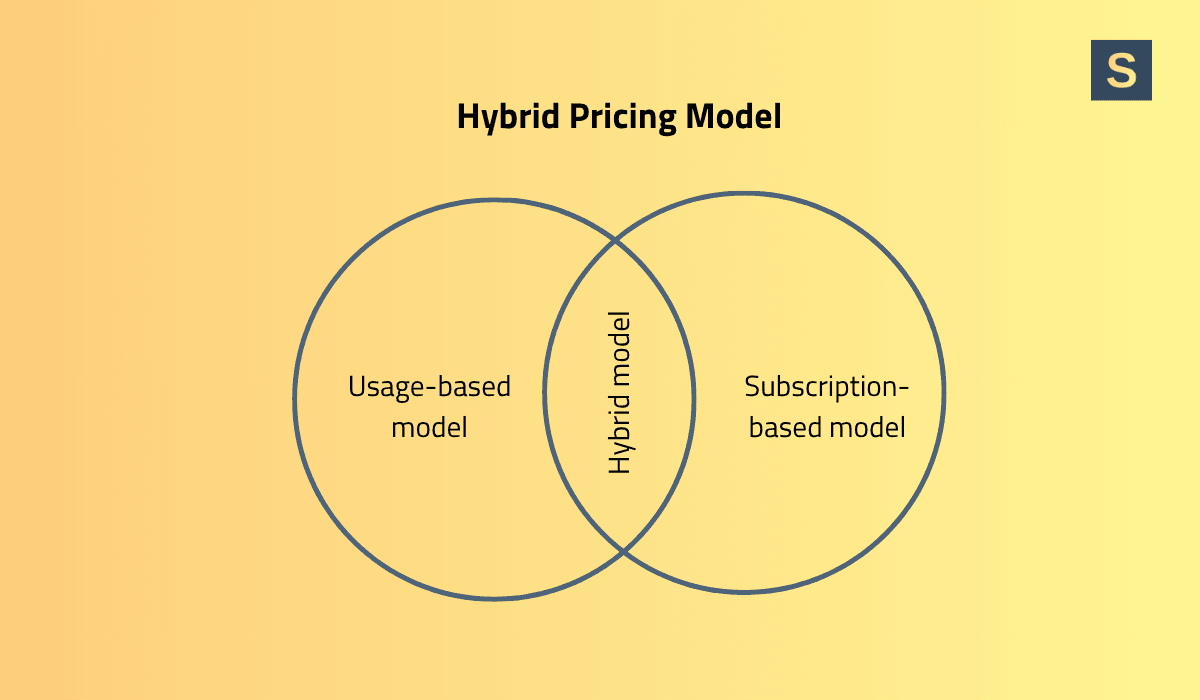
Hybrid pricing combines fixed subscriptions with usage billing, add-ons in modular form, or tiered thresholds. By adding usage-based components to your product, you can offer value to specific customers without raising prices for those who are not interested in that functionality. According to statistics, hybrid pricing drives 12% higher retention.
Why it matters:
Hybrid pricing removes adoption obstacles for small customers and unlocks expansion revenue as usage increases. It also facilitates increased product feature or service experimentation.
Success story:
Since Snowflake began combining their subscription model with consumption-based pricing, their net revenue retention rate has increased by 171%.
Integration-First Strategy: Ecosystem-Centric Architecture
SaaS buyers today expect software to be easily integrated into their existing technology stack. That’s why SaaS leaders should prioritize integrability by design. This means emphasizing robust APIs, native connectors, and pre-built integrations to CRMs, ERPs, communications tools, and analytics platforms. In most cases, 83% of SaaS buyers rank integrations in the top three purchase considerations, even above price.
Why it matters:
Problems with integrations are one of the leading causes of SaaS churn. Businesses don't want island-hopping software. An integration-first strategy can induce product stickiness, reduce friction in onboarding, and turn SaaS into a central hub within the customer's operational network.
This is especially important for solutions such as collaborative applications, where real-time synchronization and continuous data sharing across platforms are essential to user adoption.
Seedium projects:
We usually architect modular SaaS platforms that integrate with popular tools like Salesforce, HubSpot, Slack, and Stripe. For product-led teams, this accelerates time-to-value and viral adoption throughout businesses.
Read also: How to Build a Collaborative App: Technologies and Best Practices
Personalization: Intelligent User Experiences at Scale
According to statistics, personalized product experiences can increase user retention by as much as 25%. This is especially true in more sophisticated B2B software with longer learning curves. This trend aligns with broader industry findings: companies that prioritize personalization generate 40% more revenue than their slower-growing peers.
Why it matters:
Personalized user experiences in SaaS trends drive adoption and long-term retention, especially on complex B2B products. By customizing onboarding flows and in-app interactions according to individual user roles and behaviors, businesses can reduce friction, accelerate value delivery, and build stronger bonds from day one.
Success story:
We all know the success of Netflix's recommendation engine, which enables 80% of viewing to come from recommendations. Another example is Mixpanel, which received positive feedback from users after implementing role-based custom dashboards.
SaaS Technology Trends 2025: Innovation Beyond the Cloud
The SaaS industry rapidly evolves from fixed web-based applications to cognitive, adaptive platforms fueled by AI, composable architecture, and real-time computing. Leaders in the Software-as-a-Service industry grow cloud capacities and reshape application development, security, and delivery. Next-generation SaaS success is marked by agility, automation, and intelligence baked into product DNA.
The year's leading SaaS technology trends are divided into four categories: AI-native design, infrastructure innovation, security designs, and next-gen development practices. Below are closer looks at what is reshaping the future of SaaS technology.
AI-Native Solutions: Smart from Day One
Unlike AI-augmented software, AI-native apps are developed from the ground up with predictive logic and machine learning leading the charge. Companies that use AI in SaaS development command higher valuations because they can grow more quickly, iterate more intelligently, and produce stickier products. They go beyond stable workflows to deliver a dynamic, continuously improving user experience.
Why it matters:
AI-native SaaS can fine-tune performance, tailor features, and make decisions independent of human input. Such an approach eliminates enormous operational overhead and maximizes end-user productivity.
Seedium projects:
AI Ignition is a smart resume builder that uses AI as a killer feature. The product is designed to help job seekers create more relevant CVs to increase their chances of getting hired. AI functionality favorably distinguishes the application from similar ones on the market and lays an excellent foundation for the further implementation of new features.
Learn more about the case: AI Ignition - Smart resume builder
Low-Code & No-Code Platforms
Low-code/no-code (LCNC) platforms enable non-developers to create and tailor software applications with visual tools and process-based methods, with little or no coding. Through 2026, 75% of all new apps will be developed using LCNC tools, representing a sixfold increase from 25% in 2020. This SaaS trend creates a new wave of “citizen developers” and reduces the burden on traditional IT teams.
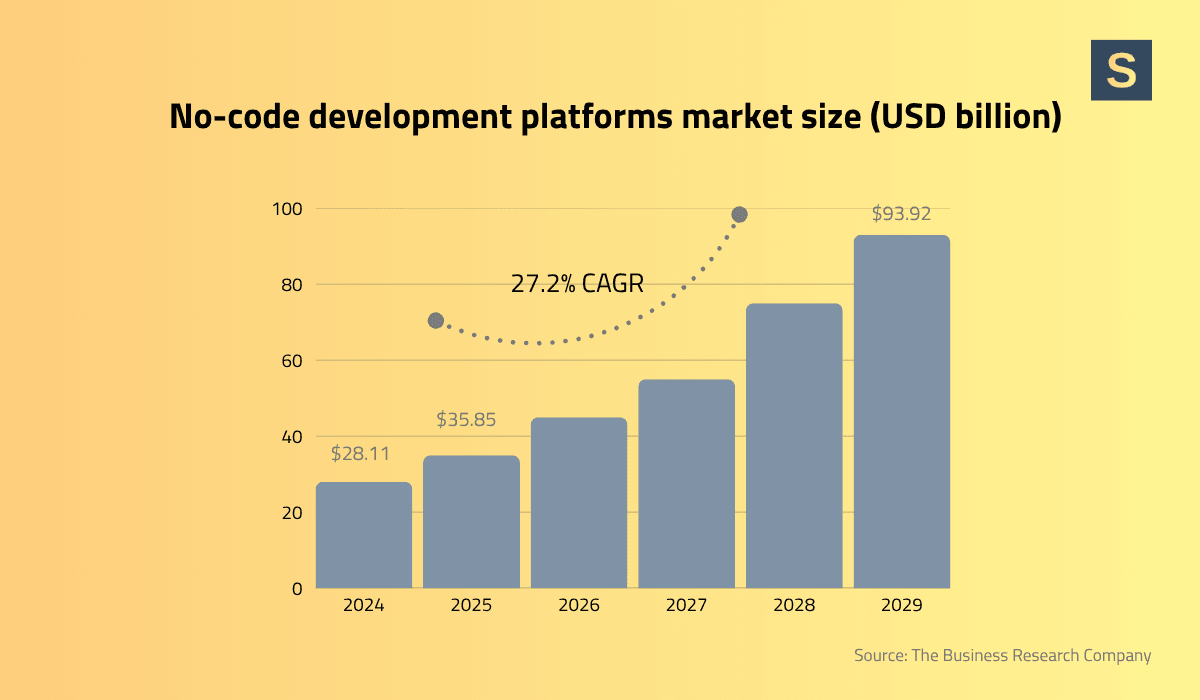
Why it matters:
LCNC dramatically accelerates development time, supporting rapid prototyping, rapid iteration, and more team involvement in product development. This is extremely valuable for startups, SMBs, and limited-resource product teams.
Example:
Tools like OutSystems, Bubble, or Glide help marketing, ops, or HR teams design internal or customer apps in days, not months. It’s important to note that LCNC solutions can’t be used to build full-fledged, scalable SaaS, but they are helpful in prototyping and testing new features before investing in development.
Serverless Architectures: Code Without the Infrastructure Headaches
Serverless computing decouples infrastructure management so developers can deploy functions and services without operating servers. This SaaS trend accelerates time to market and simplifies scaling. For example, you can be sure that your system will remain stable during high load during holidays or viral promotions.
Why it matters:
Serverless architecture is more scalable and cheaper with pay-as-you-go. It also allows teams to work on business logic only without doing DevOps. SaaS companies and agile teams that wish to iterate quickly without being weighed down by infrastructure constraints can especially benefit from this trend.
Example:
AWS Lambda, Google Cloud Functions, and Azure Functions are the front-runners in this industry. They provide native support in most current SaaS deployment workflows.
Edge Computing: Edge Data Processing for Real-Time Insights
Edge computing involves computing data closer to where it's generated, on local devices or servers. For SaaS companies, that means lower latency, improved performance, and greater reliability, especially in bandwidth-limited or time-sensitive environments. SaaS providers can offer faster, more responsive applications by combining edge computing with cloud-based services.
Why it matters
SaaS in applications in fields such as IoT, telemedicine, and smart logistics require faster response and better performance, particularly in low-connectivity or distributed environments. Edge computing, as one of the SaaS trends, makes it possible to minimize downtime and reduce the reliance on constant Internet access.
Use cases:
Edge computing is crucial for mission-critical applications where every millisecond counts. These include monitoring patient vitals, optimizing delivery routes, or managing smart factories. For example, a healthcare SaaS application could authenticate patient vital signs on the device before synchronizing with the cloud, enabling real-time alerts without delay.
Data-as-a-Service (DaaS): Real-Time Access, Zero Maintenance
Data-as-a-Service (DaaS) is a cloud approach that provides organizations with real-time access to high-quality, ready-to-use information through APIs, without building or maintaining complex data infrastructure. This data is commonly cleaned, standardized, and optimized for immediate use in applications, dashboards, and analytics programs. This approach allows companies to scale data access easily, consolidate multiple data sources, and stay flexible in data-driven decision-making.
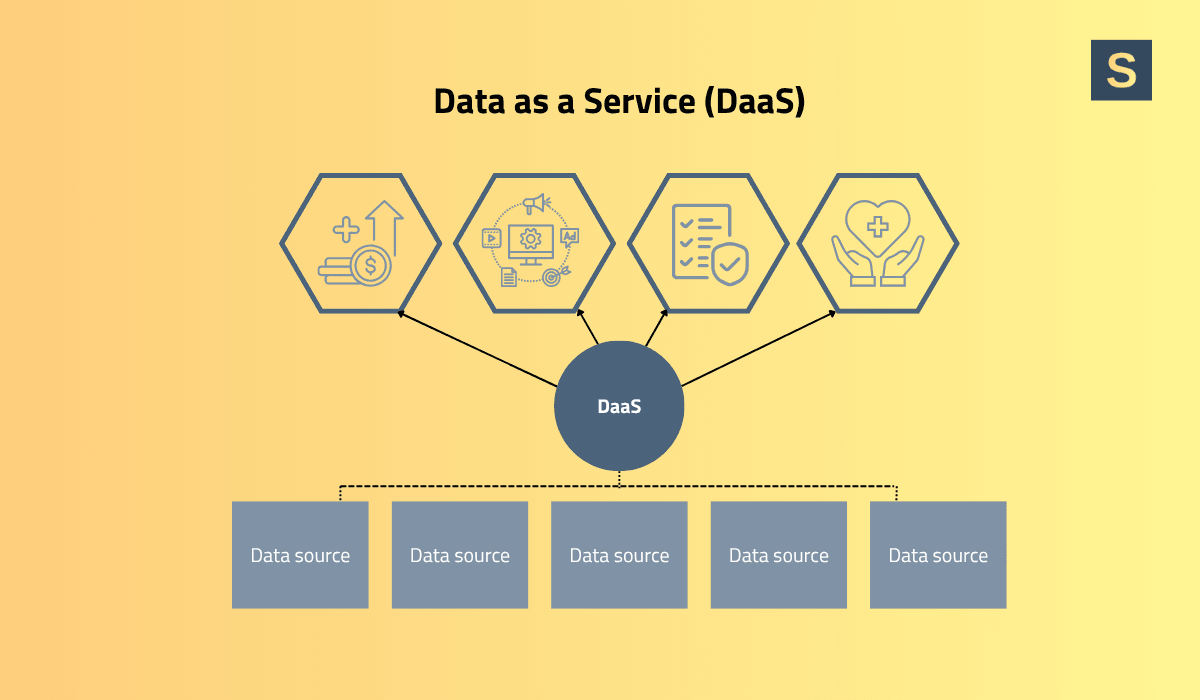
Why it matters:
DaaS enables business leaders to enrich their products with third-party intelligence and offer their customers insights without becoming data wranglers. You can accelerate AI adoption and allow teams to focus on delivering value rather than building infrastructure by outsourcing tasks of data collection, cleansing, and managing to DaaS.
Use cases:
It is especially powerful in finance, marketing, and supply chain domains, where real-time insights can directly affect strategic outcomes. For example, CRMs and marketing automation systems rely on DaaS to inject firmographics, contact data, or predictive scores directly into end-user workflows.
SaaS Security Trends 2025: Built-In, Not Bolted On
SaaS security is a board-level concern. Customers demand stronger protection and regulators are tightening compliance. In response, providers must build trust through their architecture, not just documentation. Let’s look at the top SaaS trends in the security aspect.
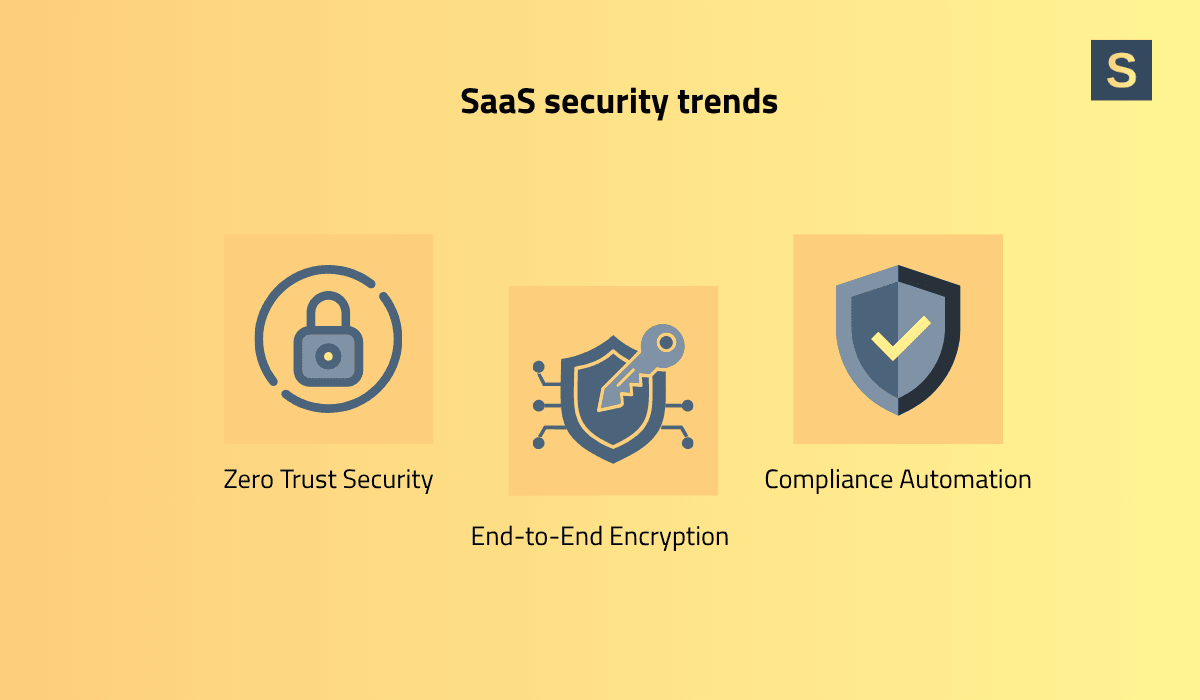
Zero Trust Security Models: Every Access Request is a Risk
The Zero Trust model follows the "never trust, always verify" premise that requires continuous authentication and tight policy enforcement, even inside the network perimeter. More SaaS vendors are including identity-aware proxies, device trust indicators, and fine-grained permissions in core workflows to meet enterprise security needs.
Why it matters:
This approach reduces lateral movement within a breach and blocks illegitimate access between distant teams and hybrid cloud environments. For SaaS providers, applying Zero Trust principles not only supports better adherence to industry standards but also promotes customer trust.
End-to-End Encryption: From Device to Database
End-to-End Encryption (E2EE) is a method of encryption where data is encrypted on the transmitting device and only decrypted on the recipient device. This way, no third party can see the content while it is in transit or stored. Such an approach allows you to avoid interception or unauthorized usage during communication.
Why it matters:
The E2EE SaaS trend can be required by privacy-focused SaaS applications such as health tech, legal tech, and fintech, which need to build customer trust and remain GDPR and HIPAA compliant. E2EE is also a strong differentiator in highly competitive markets. It focuses on data protection and safeguarding users from eavesdropping, leaks, or insider attacks.
Compliance Automation: Scaling Governance Without Bottlenecks
Compliance Automation is the process of using software platforms and tools to monitor and impose regulatory rules automatically on an organization's processes. Such platforms monitor changes in regulations and standards, audit policy enforcement, offer audit trails, and provide real-time compliance reports.
Why it matters:
SaaS vendors can reduce regulatory burden, cost, and effort and accelerate entry into the market, particularly if they sell to regulated entities. However, it is important to understand that automation should be used as an additional tool here, and the final decision should be made by a human expert to avoid costly mistakes.
SaaS Development Trends 2025: Building Smarter, Leaner, Faster
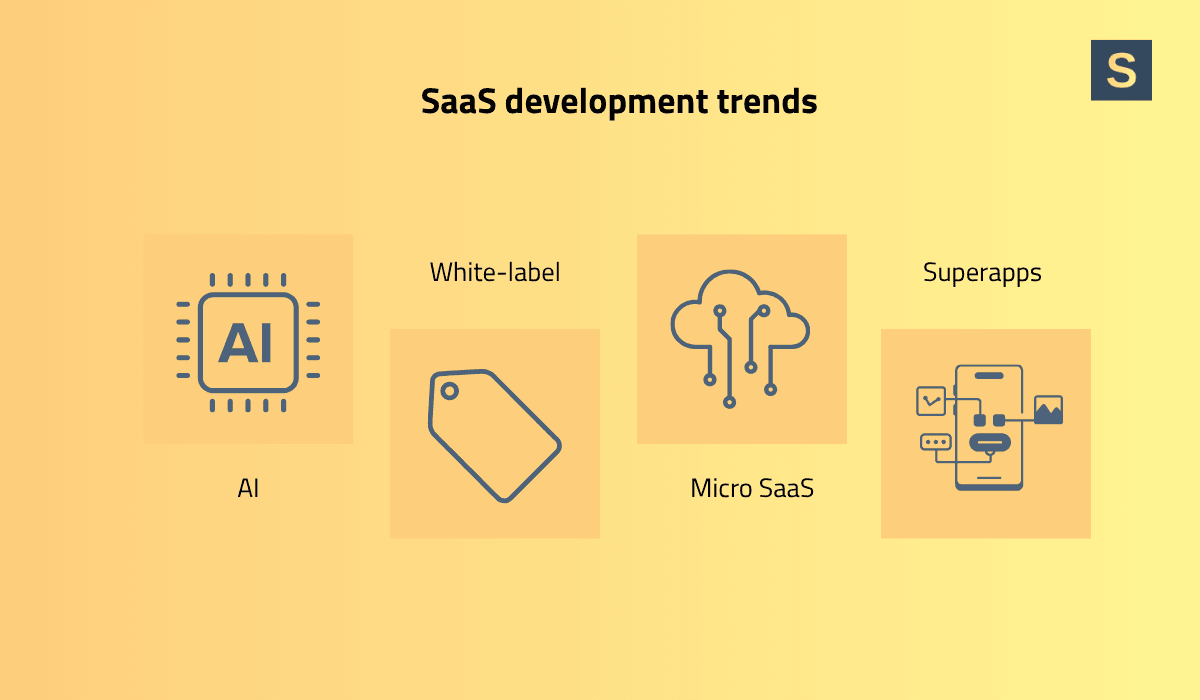
From AI-accelerated MVPs to modular architectures, SaaS teams are redesigning how they prototype, launch, and scale software. Recent SaaS trends show that development is now focused on adaptability, monetization, and speed.
AI for MVP Development: From Concept to Prototype in Days
AI-driven development tools like GitHub Copilot, Replit, and Claude make it easier to build minimum viable products. They can assist developers in code generation, testing, and creating skeleton out interfaces. However, it is critical to recognize where AI can speed up workflows and where human experience is still paramount for architectural choices, scalability, and eventual maintainability.
Why it matters:
Startups and innovation teams can validate ideas faster, reduce development costs, and deliver more value earlier by incorporating AI into their development processes. According to a McKinsey study, artificial intelligence increases the speed of coding by 35–45%.
Seedium experience:
At Seedium, we combine the capabilities of AI automation with human expertise to speed up development cycles for our clients. This helps to achieve project goals with optimized budgets and accelerates time to market.
“While AI is getting better at writing and understanding code, it still lacks a true understanding of why you’re building something - the goals, tradeoffs, priorities, and context behind decisions. That’s where human developers are essential.”
Denys Dovzhenko, React Native developer at Seedium
Read also: How to Make Your Vibe-Coded App Secure and Scalable
White-Label SaaS: Faster Growth, Broader Reach
White-label SaaS is software that can be customized for a specific brand without having to build it from scratch. It's one of the most used models in fintech, martech, and HR tech, where brand customization and time-to-market are key differentiators. The white-label model allows companies to expand their product portfolio quickly and cost-effectively. You can focus on customer relationships and market positioning rather than software development.
Why it matters:
This SaaS trend accelerates product launch, creates new paths to market, and enables scalable growth without investments in self-reliant development teams. It also gives vendors multiple opportunities to monetize their platforms across brands or markets.
Micro SaaS: Niche Wins with Lean Products
Micro SaaS products are narrowly targeted solutions developed for small, underserved markets. They usually solve one problem well, such as calendar syncing for tutors or invoicing for local tradespeople. They are ideal for bootstrapped founders looking for sustainable businesses due to their simplicity, low maintenance needs, and direct customer relationships.
Why it matters:
Micro SaaS businesses can quickly become profitable and viable in the long term. All this is thanks to low operational costs, minimal dependencies, and customer feedback. They don't require a massive scale to succeed and end up building tight-knit and loyal user communities.
SaaS Superapps: One-Stop Shops with Embedded Ecosystems
At the other end of SaaS trends are superapps that incorporate multiple business-critical tools into one app. Imagine CRM, payments, chat, reporting, and more in a single app. SaaS superapps are perfect for users who value convenience, centralization, and optimized workflows. Superapps reduce the need for multiple subscriptions and improve operational efficiency. This makes them especially attractive for small businesses and startups that aim to streamline their tech stack.
Why it matters:
Super apps improve product retention and value by reducing the need for integrations and improving the ease of daily use. They become vital operation hubs that allow businesses to run everything in one place. Superapps are a strong go-to-market strategy, especially in vertical SaaS and emerging markets.
API-First Development: Designing for Ecosystem Growth
While APIs were once used to connect parts of a system, today they are stand-alone products that can generate additional revenue for a business. Recent research shows that about 62% of developers work with APIs that generate income. This indicates the growth of the API-as-a-product model, which enables easier scalability and strengthens ecosystem partnerships.
Why it matters:
An API-first approach can greatly accelerate the SaaS development process, allowing web, mobile, and third-party integrations to be built in parallel. It also helps engineers to avoid the “afterthought API” problem that leads to messy refactoring later. At the same time, APIs can be monetized directly and provide new revenue streams for businesses.
Read also: How to Successfully Build and Scale Your SaaS Product
SaaS Growth Trends 2025: Scaling with Intelligence
Finally, let’s close the overview of SaaS trends with those related to scaling and growth.
Data-Driven Product Growth: Every Click Counts
Product development teams now make decisions based on real usage data, rather than relying on assumptions. Behavioral analytics, heatmaps, feature adoption metrics, churn signals, and user journey maps help understand what truly matters to users. Data-driven approach leads to faster iterations, smarter prioritization, and more impactful features, driven by what people actually do, not just what they say.
Why it matters:
This approach eliminates the guesswork and minimizes the risk of building features no one wants. You can enable faster iteration, smarter prioritization, and better communication of ROI to stakeholders with data-backed strategies. In the near future, the implementation of advanced product analytics will become the norm, but for now, it can be a strong competitive advantage for market players.
Example:
If we’re talking about ready-made solutions, Mixpanel, Amplitude, and PostHog are great examples of analytics tools. They help companies better track user behavior and make decisions based on real data insights.
AI Agents & Embedded Assistants
AI agents are intelligent embedded assistants in SaaS interfaces that support users, suggest actions, automate routine tasks, and answer questions in real-time. They offer advanced workflow support to help users navigate complex software. Modern agents can adapt to context, learn from behavior, and significantly reduce onboarding time, making even sophisticated tools intuitive.
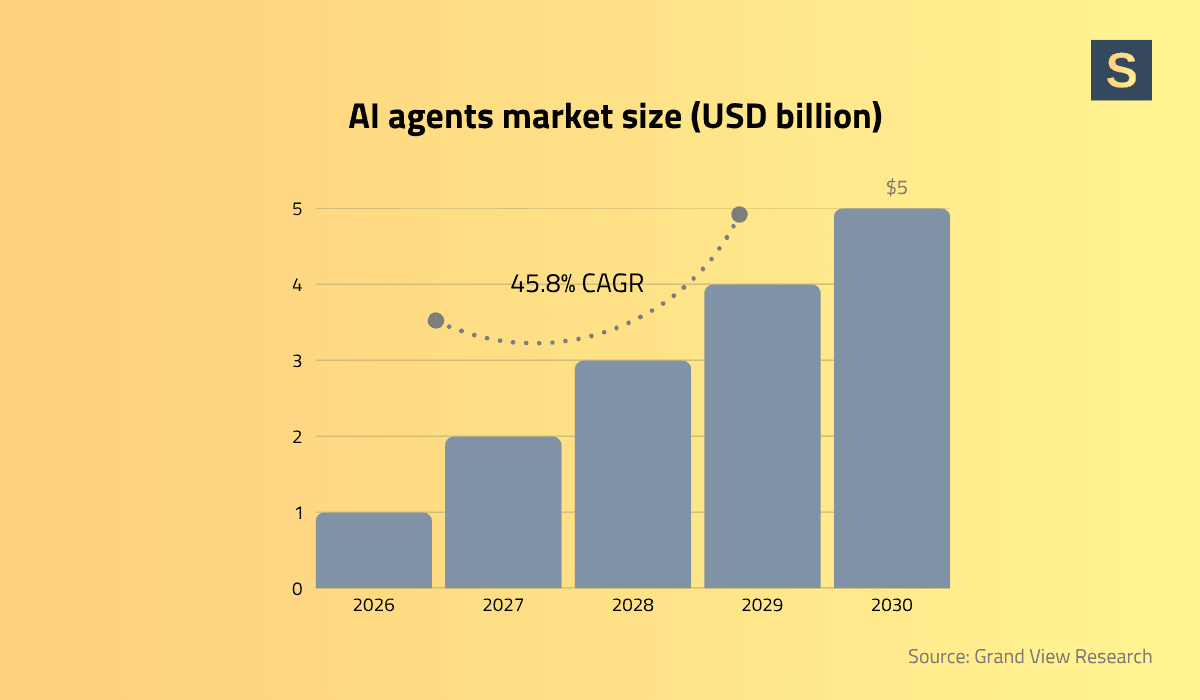
Why it matters:
AI agents reduce friction during onboarding, lower support costs, and significantly improve time-to-value. Modern users, accustomed to Chat GPT, expect natural conversations with chatbots and assistants inside the software they use. Since the development of large language models is only gaining momentum, we should expect AI assistants to be a must-have feature in SaaS products.
Modular SaaS Architectures: Built to Evolve
Modular SaaS architecture involves building software as a collection of standalone components or modules. Each module delivers a specific function (e.g., billing, authentication, analytics) and can be independently added, replaced, or scaled.
Modularity allows SaaS providers to innovate faster, customize features by client segment, and stay compliant in regulated verticals. It also enables more straightforward integration with third-party systems and faster time-to-market for new offerings.
Why it matters:
Modularity allows SaaS companies to future-proof their offerings by innovating on a particular component without disrupting the remainder of the platform. With a modular architecture, product development teams can quickly experiment, release features targeted to specific segments, and seamlessly adapt to changing customer needs.
Read also: Scaling Your Business with Scalable Software Architecture
Wrapping Up: What is The Future of SaaS
The SaaS industry is entering a phase of innovation, maturity, and specialisation. Key SaaS trends, such as the emergence of AI-native apps, vertical SaaS, low-code/no-code platforms, and modular architectures, are revolutionizing how software is developed and delivered to end-users.
Security and compliance are no longer backend concerns but frontline aspects of product strategy. Companies are placing trust and data defense at the forefront of an increasingly digital-first reality. At the same time, customer-facing innovations like personalization, AI-powered assistants, and hybrid pricing models are setting a new standard for user experience and retention.
Ultimately, the SaaS providers that succeed in the next few years are those that:
- Adopt AI and automation for speed, accuracy, and scale.
- Provide custom solutions to meet unique customer needs.
- Create flexible, interoperable systems with ease of integration into larger business ecosystems.
- Make security, performance, and compliance differentiators, not checkboxes.
Feel free to check out our SaaS app development services or reach out directly if you’re looking for a reliable partner to build and scale your SaaS business.



